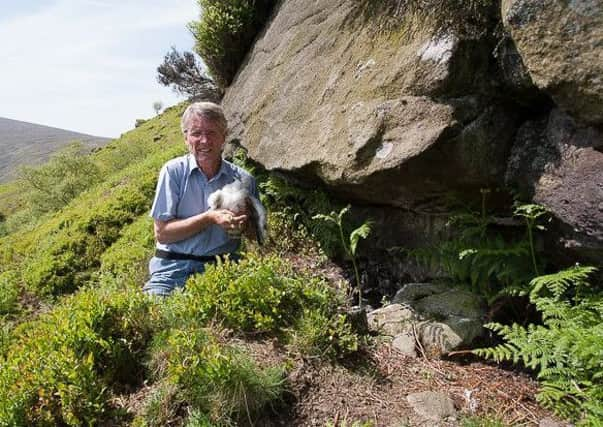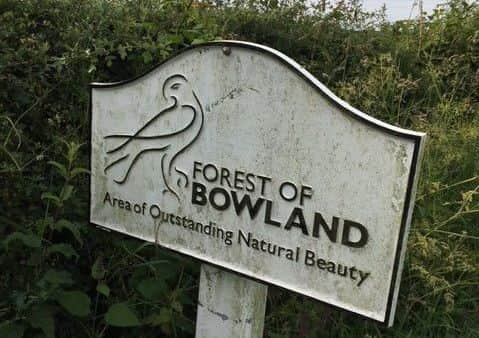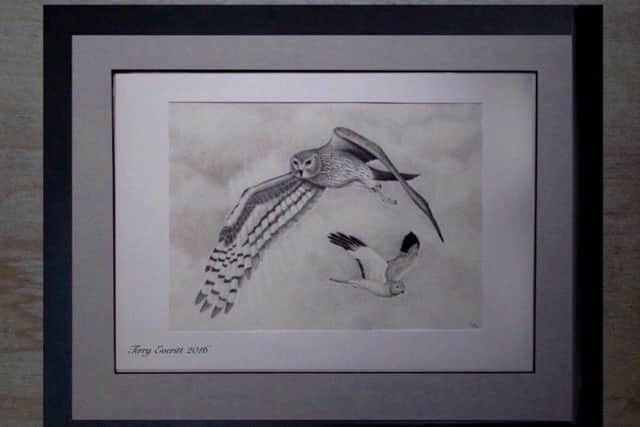Battle to save Bowland's skydancers


Once, not so very long ago, hen harriers soared over Bowland.
Their wings outstretched, these magnificent birds would swoop across the landscape demonstrating to spellbound onlookers why they are called skydancers.
Advertisement
Hide AdAdvertisement
Hide AdTerry Pickford remembers those days when this local AONB (Area of Outstanding Natural Beauty) was home to harriers: “I remember when Bowland was the jewel in the crown for raptors. But that was when there were no landrovers and no quad bikes. Raptors are the apex. They are right at the top of the food chain. They are so beautiful”


But now the veteran campaigner believes the Bowland AONB should remove the harrier from its logo - because there aren’t any nesting here any more.
He said: “The logo for the Forest of Bowland is the hen harrier. It’s a very proud logo but we’ve no harriers so it’s a very big embarrassment. They should take the sign away.”
In 2014 two hen harriers, Sky and Hope, were tagged in Bowland. They and their tracking equipment disappeared in north Bowland a few weeks after leaving their nest.
Advertisement
Hide AdAdvertisement
Hide AdIn 2015 four male hen harriers never returned to their nests in Bowland, which meant female harriers had to go in search of food and it is estimated up to 25 eggs went cold. In 2016 and 2017 no pairs nested in Bowland.


Terry, Chairman of the North West Raptor Protection Group, is busy organising a special education and campaign event to focus on the plight of the hen harrier here.
The fourth Hen Harrier Day will be held on the green at Dunsop Bridge on Sunday August 6 from 10.30am.
Guest speakers will include actor Nick Miles who plays Jimmy in TV’s “Emmerdale Farm”, Natalie Bennett the former leader of the Green Party, retired former RSPB (Royal Society for The Protection of Birds) senior ecologist Brian Etheridge and owl expert Chrissie Harper, as well as Terry.
Advertisement
Hide AdAdvertisement
Hide AdA special poem ‘Where are our Skydancers?’ by Tim Ellis will be read at the event and three works of art auctioned.


Terry, pictured ringing another endangered bird of prey - the peregrine falcon, said: “We’re hoping that families will come along with their children. We need education and we are educating more people as to what’s going on and they are definitely taking an interest.”
He continued: “There were no breeding hen harriers on any English red grouse moorland during 2016 and 2017, when there should be at least 320 breeding pairs. The current position is a total disgrace for our country. There were only two breeding pairs of peregrine in 2017, when 16 plus pairs existed in 2009.”
Terry’s interest in birds of prey was sparked at an early age. At five, living in Derbyshire, he was captivated learning about Golden Eagles. Then, at seven, he and his family moved to Canada for two years and the passion grew. By the time the family returned to Britain, settling in Blackpool, Terry, a former technical assistant with United Utilities, was truly smitten.
Advertisement
Hide AdAdvertisement
Hide AdArguing it was the inaccessibility of nesting sites which gave the birds protection in the past, he said: “These birds don’t just go and commit suicide. Birds of prey have territories and come back year after year. They disappear for a reason and it’s man made. All the evidence is there, destroyed nests, smashed eggs, even footprints going into the nests.”


For decades he has been a champion of birds of prey and has been outspoken about the conflict between conservationists and those seeking to maintain high grouse populations for shooting.
In turn the Game and Wildlife Trust says 82 pairs of harriers in England would be “a sustainable number” and red grouse shooting generates £100m for the UK economy. In its briefing paper ‘Hen Harrier Recovery’ it notes: “The harrier-grouse conflict can make moorland management uneconomic. Hen harriers eat grouse. If there are enough to make a shoot uneconomic, the gamekeepers lose their jobs, and numbers of ground-nesting birds decline, including ones of conservation concern such as waders.”
Bowland based Amanda Anderson, Director of the Moorland Trust, said: “Bowland was a stronghold for hen harriers and it’s very disappointing there haven’t been any successful nests this year. We’re very much part of the hen harrier recovery plan which is to get the hen harrier back across its former range - that’s the whole of England ... Clearly if there’s a conflict with game interests that’s why we are working very hard with Government to have a pragmatic solution.”
Advertisement
Hide AdAdvertisement
Hide AdShe said landowners could be put off welcoming and hosting hen harriers because they are “a semi colonial nester” which can settle in a very small area: “If a mum and dad are feeding four or five chicks that’s quite a lot of food, that’s 2,000 meals in a six week period and if there’s a colony that’s a lot of meals. They will eat grouse. They will eat whatever they bump into first.”
She says one solution, if nests are in close proximity, is to leave one nest intact and move other eggs to an aviary where chicks can be reared and returned to an appropriate area of northern England. Another option is to encourage “diversionary feeding” where other food sources are provided for harriers to discourage their predations.
This week bird charity the RSPB, which has a special Bowland Project Officer, James Bray, warned harriers are on the brink of extinction in England as a breeding species with just four territorial pairs recorded in 2016.
James said: “Hen harriers are doing appallingly badly to be honest. There is suitable habitat for more than 300 pairs of hen harriers in England and this year there are just a handful. There were none on a driven grouse moor and last year not a single nest in Bowland. Bowland used to be the national English stronghold of hen harriers. Some years Bowland was the only place in England to have harriers nest. They didn’t breed here last year and we’ve not had any this year.”
Advertisement
Hide AdAdvertisement
Hide AdCommenting on the national picture, he said: “Birds are still being shot and trapped and nesting attempts fail for unexplained reasons on a scale which just doesn’t happen away from areas where there’s no grouse shooting.”
He added: “We don’t have any hard evidence of illegal persecution of hen harriers in Bowland.”
There are concerns too about the plight of peregrine falcons, as James explained: “For peregrines the situation is remarkably similar. Peregrines nested successfully in Bowland in every year between 1991 and 2015. In both 2008 and 2009 ten pairs of peregrines nested successfully in Bowland, but numbers have crashed to the point where in 2016 only two pairs laid eggs but both nesting attempts failed. This was the first year for over thirty in which no peregrine chicks fledged from Bowland. This year (2017) two pairs have successfully bred.”
James can call on a team of fellow RSPB staff and volunteers to mount watches on harrier nests in parts of Bowland, but says as harriers fly 8km or more from their nests when hunting, it can be difficult to protect them.
Advertisement
Hide AdAdvertisement
Hide AdIt became illegal to kill hen harriers and most other birds of prey in 1954. The Wildlife and Countryside Act of 1981 added further protections and the police urge anyone with information about raptor persecution to contact them or call Crimestoppers on 0800 555 111.
A Lancashire Constabulary spokesman said: “The police are aware of concerns nationally and locally of the disturbance and persecution of hen harriers and their nests. We are committed to working with partners including the RSPB and landowners to try and improve hen harrier breeding. A range of factors can affect bird of prey breeding but where illegal activity or persecution of birds of prey is reported or suspected police will always seek to act.”
DEFRA (the Department for Environment, Food and Rural Affairs) published a six point action plan in January 2016 to coordinate action by conservation groups, landowners and wildlife crime officers across the country.
A spokesman for the National Gamekeepers’ Organisation (NGO) said: “The NGO condemns absolutely the persecution of birds of prey and, where it exists, it must stop. There is no place for raptor persecution, or indeed any other wildlife crime, in the countryside.
Advertisement
Hide AdAdvertisement
Hide Ad“By the same token, it is impossible for those who work in rural areas, blameless of any wrong doing, to prove a negative and to demonstrate their innocence in the court of public opinion. Which is one reason why the NGO is supporting Defra’s Hen Harrier Joint Action Plan as it provides an effective means to bring together those with an interest in the uplands and birds of prey to the benefit of all concerned, human and avian.”
He added: “Science has shown that when driven grouse shooting ceases wildlife declines follow hard on its heels, including big drops in numbers of hen harriers, Indeed, once driven grouse shooting stops some species of wading birds have been shown to become virtually extinct locally.”
Amid the controversy Bowland AONB says it is hanging on to its harrier logo. A spokeswoman said: “There are no plans to change the logo at this time. The hen harrier is symbolised in the partnership logo for the AONB, and has been for many years, therefore any changes would only be made through careful consideration and consultation with the partnership.”
The AONB is part of the Northern England Protected Landscapes Group for Hen Harriers and says it supports the national Hen Harrier Joint Action Plan.
Advertisement
Hide AdAdvertisement
Hide Ad•Fundraiser: A pen and ink drawing of two hen harriers in moorland landscape by Terry Everitt, (pictured), will be auctioned, along with two other works of art at the Hen Harrier Day in Dunsop Bridge. Bids can also be submitted online.